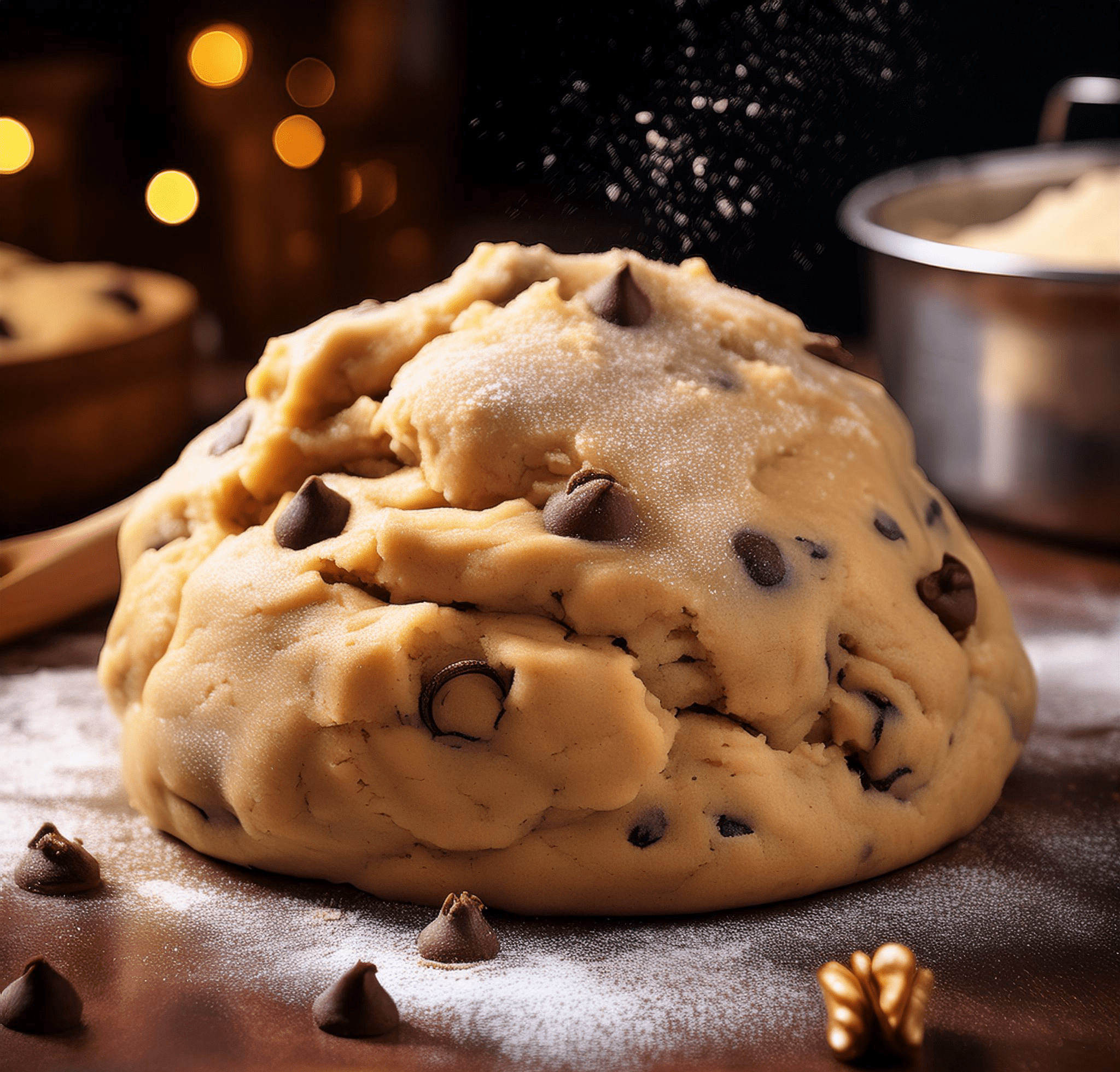Table of Contents
Introduction
Imagine walking into a kitchen where the air is filled with the comforting aroma of freshly baked cookies. Their edges are perfectly golden and crisp, while the centers remain irresistibly gooey. Now, envision taking that first warm bite—an experience of pure, sweet satisfaction. Achieving this delightful result isn’t just a stroke of luck; it all starts with a truly exceptional cookie dough recipe. If you’ve ever felt frustrated by flat, lifeless cookies or dough that won’t cooperate, it’s time to elevate your baking game. What if there was a way to ensure cookie success every time? A foolproof formula for crafting the right batch, no matter the occasion?
This guide will help you master cookie dough basics. By unlocking the secrets to a recipe that never fails, you’ll open up endless possibilities in your baking adventures. Don’t settle for ordinary results; aim for the extraordinary. Dive in and discover the steps to becoming the cookie master you’ve always dreamed of being. Ready to transform your kitchen into a paradise of baking perfection? Let’s get started.
Why You Need a Cookie Dough Recipe That Never Fails
Baking cookies can be a gamble—sometimes they come out overcooked, undercooked, or lacking in flavor. A fail-safe cookie dough recipe removes this uncertainty, allowing you to bake with confidence every time. Whether you are just beginning your baking journey or you’ve been at it for years, knowing the right recipe guarantees you can consistently create soft, chewy, and delicious cookies.
Common Pitfalls in Cookie Dough Making
Even experienced bakers can slip up when making cookie dough. Some frequent mistakes include overmixing the dough, which makes cookies tough, or using incorrect measurements that throw off texture and flavor. Baking at the wrong temperature or using stale baking soda can also result in flat or uneven cookies. Knowing these common pitfalls will help you avoid them and achieve the most delicious cookie every time.
Understanding Cookie Dough Fundamentals
To make a cookie dough recipe that never fails, you first need to understand the key ingredients and their roles. Cookie dough, in its simplest form, is a blend of flour, sugar, butter, and leavening agents. However, the real magic happens in how these components interact. Understanding the purpose of each ingredient will help you create a dough that bakes into cookies with a chewy interior and a slightly crispy edge.
Key Ingredients in a Cookie Dough Recipe
- Flour: Provides structure. Different types, such as all-purpose, bread, or cake flour, affect the texture.
- Sugar: Adds sweetness and browns. Granulated sugar yields a crisper texture, while brown sugar adds moisture for a chewier cookie.
- Butter: Adds richness and flavor while influencing texture; butter makes cookies crisp around the edges.
- Eggs: Bind ingredients and contribute to texture and moisture.
- Vanilla & Salt: Enhance the overall flavor.
- Leavening Agents (Baking Soda & Baking Powder): Help the dough rise and create the desired texture.
The Role of Each Ingredient in Perfect Cookie Dough
Each ingredient has a distinct purpose in creating the ideal cookie dough:
- Flour forms the foundation by providing structure. The type and amount of flour determine whether cookies are dense or light.
- Sugar sweetens and caramelizes during baking, giving cookies a golden color and rich flavor.
- Butter enhances moisture and adds creamy, rich mouthfeel.
- Eggs provide structure and velvety texture.
- Leavening agents like baking soda and baking powder make the dough rise, producing the light, tender crumb you want.
Essential Tools for Perfect Cookie Dough
To make cookie dough that consistently works, you need the proper tools:
- Measuring Cups and Spoons: Accurate measurement is the key to consistency.
- Sturdy Spatula and Mixing Bowl: For easy mixing.
- Stand Mixer or Hand Mixer: Helps cream butter and sugar effectively.
- Baking Sheet and Parchment Paper: Ensures even baking and easy cleanup.
Must-Have Baking Tools for consistency
Investing in quality tools can greatly improve baking results:
- Digital Kitchen Scales: Precision measurements.
- Cookie Scoops: Create evenly sized cookies that bake uniformly.
- Silicone Baking Mats or Parchment Paper: Prevents sticking and promotes even browning.
- Oven Thermometer: Verifies your oven’s true temperature.
- Cooling Rack: Ensures cookies cool evenly and don’t become soggy.
Choosing the Right Ingredients for the Perfect Cookies
Ingredient quality significantly affects your cookies’ outcome. Choose unbleached all-purpose flour for its balanced protein content. Use a mix of white and brown sugar for the ideal combination of sweetness and moisture. Ensure your baking soda and baking powder are fresh for proper leavening, and always opt for unsalted butter to control dough saltiness.
Selecting the Best Flour and Sugar for Your Cookie Dough
- Flour: All-purpose flour is suitable for most recipes, but cake flour yields a tenderer cookie, and bread flour offers a chewier texture.
- Sugar: Granulated sugar gives a crisp texture, while brown sugar adds moisture for a soft, chewy cookie. Using a mix provides the benefit of both worlds.
Importance of fresh leavening agents
Fresh baking soda and baking powder are essential for the right texture. Stale ingredients can lead to flat and dense cookies. Always check expiration dates and store ingredients properly.
Step-Step Guide to the Best Cookie Dough
Measuring Ingredients: The Key to Success
Accurate measurement is crucial in baking. Use a kitchen scale for precision, especially with flour, which can be overmeasured with a cup. Even slight deviations can change the texture and overall quality of your cookies.
The right mixing techniques
Mixing cookie dough correctly is more critical than you might think. Properly creamed butter and sugar create tiny air pockets that help the dough rise. Overmixing can make cookies tough by introducing too much gluten. Mix until the ingredients are combined for a tender texture.
Why resting your dough matters
Allowing your dough to rest in the refrigerator helps the flour fully hydrate and flavors meld together, resulting in a more complex taste and texture. Chilling the dough also solidifies fats, reducing spread during baking and producing thicker, chewier cookies. Ideally, chill the dough for at least 30 minutes, but overnight is best.
Tips for Achieving the Perfect Cookie Texture
- Chewy Cookies: Use more brown sugar and underbake.
- Crispy Cookies: Use more granulated sugar, bake longer, and allow them to cool completely.
Experimenting with dough temperature
Dough temperature affects cookie texture. Room temperature dough spreads more, leading to thinner, crisper cookies, while chilled dough retains its shape better, resulting in thicker, chewier cookies. Play around with temperatures to find your ideal balance.
Troubleshooting Common Cookie Dough Issues
- Sticky dough: Add more flour gradually.
- Dry dough: Add a small amount of liquid, like milk or water, to achieve the right consistency.
- Flat Cookies: Adjust measurements, chill the dough, or tweak oven temperature.
Creative Ideas for Cookie Dough Customization
- Flavor Boosters: Add vanilla, almond, or other extracts to enhance flavor.
- Mix-ins: Try chocolate chips, nuts, dried fruits, or candies to add unique textures and flavors.
Baking the Perfect Cookies: Time and Temperature Tips
Use an oven thermometer to ensure the correct baking temperature. Cookies are done when the edges are set, and the centers are still soft. They will continue to cook slightly on the baking sheet after removal from the oven.
Storing Cookie Dough and Baking Cookies
Refrigerate or freeze dough to enhance flavors and texture. Store baked cookies in airtight containers to maintain freshness. To keep cookies soft, place a slice of bread in the container, or use a silica packet to keep them crisp.
Conclusion
Mastering a cookie dough recipe that never fails isn’t just about baking; it’s about creating joy with every batch. By understanding each ingredient’s role and using the right techniques, you can transform basic ingredients into extraordinary cookies. While consistency is important, experiment with new flavors or textures. As you refine your skills, this dependable cookie dough recipe will become your secret to impressing cookies every time.
Try this recipe and experience the joy of baking the most delicious cookies. Share your creative twists and adventures with us to inspire others!
Join our community for more delicious recipes, baking tips, and kitchen inspiration. Discover related posts on cake baking, bread making, and more to enhance your baking journey!

